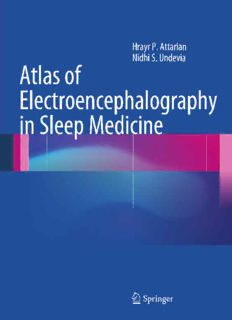
Atlas of Electroencephalography in Sleep Medicine PDF
Preview Atlas of Electroencephalography in Sleep Medicine
Atlas of Electroencephalography in Sleep Medicine Hrayr P. Attarian (cid:129) Nidhi S. Undevia Atlas of Electroencephalography in Sleep Medicine Hrayr P. Attarian Nidhi S. Undevia Division of Sleep Medicine Division of Pulmonary & Critical Care Medicine Department of Neurology Department of Medicine Northwestern University Loyola University Medical Center Feinberg School of Medicine Maywood, IL, USA Chicago, IL, USA [email protected] [email protected] ISBN 978-1-4614-2292-1 e-ISBN 978-1-4614-2293-8 DOI 10.1007/978-1-4614-2293-8 Springer New York Dordrecht Heidelberg London Library of Congress Control Number: 2011946069 © Springer Science+Business Media, LLC 2012 All rights reserved. This work may not be translated or copied in whole or in part without the written permission of the publisher (Springer Science+Business Media, LLC, 233 Spring Street, New York, NY 10013, USA), except for brief excerpts in connection with reviews or scholarly analysis. Use in connection with any form of information storage and retrieval, electronic adaptation, computer software, or by similar or dissimilar methodology now known or hereafter developed is forbidden. The use in this publication of trade names, trademarks, service marks, and similar terms, even if they are not identifi ed as such, is not to be taken as an expression of opinion as to whether or not they are subject to proprietary rights. While the advice and information in this book are believed to be true and accurate at the date of going to press, neither the authors nor the editors nor the publisher can accept any legal responsibility for any errors or omissions that may be made. The publisher makes no warranty, express or implied, with respect to the material contained herein. Printed on acid-free paper Springer is part of Springer Science+Business Media (www.springer.com) To the memory of my father, Pierre Attarian. May it remain alive in the minds of the many people whose lives he touched. Hrayr P. Attarian, M.D. To my husband, Samir Undevia, and children, Akshay and Anisha, for their unwavering support. Nidhi S. Undevia, M.D. Preface Sleep medicine is a diverse fi eld that brings together the knowledge and expertise of a variety of medical specialties. This is easily demonstrated by the fact that the physicians who practice in this fi eld come from a variety of backgrounds including internal medicine, otolaryngology, neurology, pediatrics, psychiatry, and pulmonary medicine. Despite our varied background, those of us practicing clinical sleep medicine fi nd ourselves with very similar clinical practices regardless of our primary specialty. For those of us without neurology training, we have incor- porated the review of sleep electroencephalograms (EEGs) into our daily lives, and those with- out pulmonary training have become more than familiar with oxygen desaturation, hypoventilation, and the use of supplemental oxygen. There are, however, those instances in which gaps in knowledge can challenge the limits of our training. For those fortunate enough to work in multidisciplinary sleep programs with physicians with different primary specialties, I am sure that they have come to realize the ben- efi ts of collaboration and discussion in assisting both patient care and increasing the basic fund of knowledge. It is out of the need to fi ll these gaps in knowledge where the idea for this book began. I am certain that many have had the experience when they are able to identify that something “is not right” or “looks different” about the EEG but are unable to identify the specifi c abnormality. As such, this book is intended for the sleep specialist without specifi c training in epileptology to assist with EEG interpretation during polysomnography review. This book has been organized into fi ve chapters. Chapters 1 and 2 focus on normal sleep, normal sleep stages and normal EEG variants in sleep, respectively. Chapter 3 focuses on non- epileptiform abnormalities, whereas Chap. 4 takes on epileptiform abnormalities. Chapter 5 reviews artifacts that may be seen on review of the EEG. I would like to take a moment to comment on the layout of the fi gures in this book. All fi gures are real examples from patients studied in an epilepsy monitoring unit. Each example is shown as it would appear with channels recorded during routine polysomnography; however, the order of these channels has been changed to place the left-sided leads and right-sided leads together as is done in routine EEG monitoring. Current digital systems used for polysomnography allow the user to easily change the order of leads when indicated and can be helpful in the identifi cation of EEG abnormalities. Subsequent fi gures show each topic with the full-EEG montage and then at the faster 30 mm/s paper speed used in EEG. Additional fi gures are shown, when appropriate, with reduced gains to demonstrate specifi c details about the topic in question. It is our hope that readers will use this book to increase their knowledge regarding EEG fi ndings in both normal and abnormal sleep and as an aid in polysomnography interpretation. Chicago, IL, USA Hrayr P. Attarian, MD Maywood, IL, USA Nidhi S. Undevia, MD vii Acknowledgments The authors would like to express their appreciation to Michael Macken, M.D., Rajinder Singh, D.O., and John Millichap, M.D., for their assistance in providing materials presented in this book, and to Ryan Hays, M.D., for critical review of some of the samples. Our thanks are also extended to Lee Klein for his wonderful administrative assistance throughout the project. ix
Description: